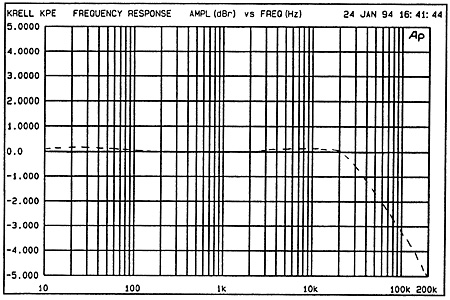| Columns Retired Columns & Blogs |
Krell KPE & KPE Reference phono preamplifiers Measurements
Sidebar 2: Measurements
The KPE proved to have versatile input facilities. Both moving-coil and moving-magnet settings featured low noise levels. The measured S/N ratio was 73dB for moving-coil (CCIR-weighted ref. 1kHz, average-responding meter), and even better for the higher signal level delivered by a typical moving-magnet cartridge. Stereo separation was better than 85dB at low- and mid-frequencies, and very satisfying higher up, typically being 68dB at 20kHz. This is better than the KRC-2.
Channel balance was ±0.05dB, a very high precision indeed. As is customary these days, the KPE's RIAA equalization was highly accurate. It was very similar for MM and MC, essentially meeting ±0.1dB limits between 60Hz to 16kHz (fig.1), with –—dB points below 1Hz and above 90kHz. There was no band-limiting at the frequency extremes, though this is often considered desirable for a phono stage: a typical LP player can generate spurious signals outside the audible range which are probably better left unamplified. These include infrasonic signals from the arm/cartridge resonance, the turntable motor, and recorded rumble, and at ultrasonic frequencies there is the tip-mass resonance peak of the cartridge as well as a likely spread of radio and other electromagnetic interferences due to the very low signal levels involved. It's not unusual to have –3dB points at 12Hz and 35kHz, the response falling to –20dB by 5Hz and 60kHz.

Fig.1 Krell KPE, RIAA error (dashed) (1dB/vertical div.).
Krell relies on very clean signal handling to avoid any problems, though this doesn't help smaller wide-range speakers when asked to reproduce infrasonic noise from a turntable, or even a digital recording with an unwanted complement of road-traffic rumble.
The KPE's input-overload margins were excellent, at typically 27dB IHF. Total harmonic and high-frequency intermodulation distortion was very low for both MM and MC setting, typically better than 86dB down (0.005%). This was better performance, in fact, than the KRC-2's line inputs.—Martin Colloms
- Log in or register to post comments




































